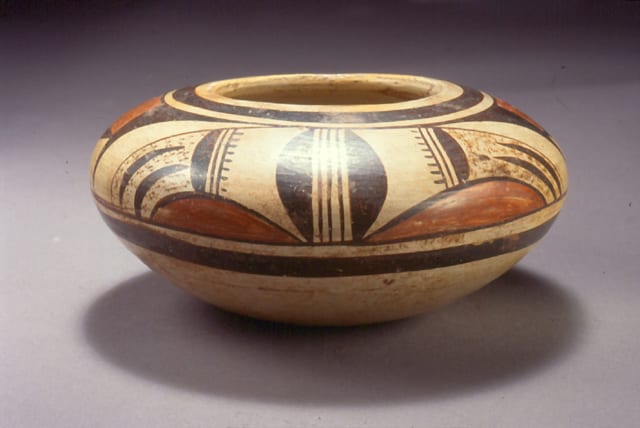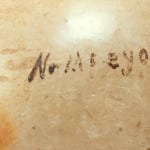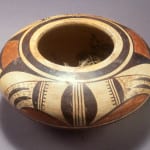Hopi seed jar, Nampeyo (ca. 1860-1942), probably painted by youngest daughter Fannie in the 1930s. (2.75” h X 5.625” w) There is an early Nampeyo signature on the bottom.
The capital “E” in the signature indicates that the design was painted by Fannie. For the logic of this conclusion, see “Appendix E.”
Between 1917 and 1920, Nampeyo became functionally blind. A photograph of Nampeyo and Fannie taken at about the time this pot was made is found in Arizona Highways (1974:16). A contemporary reference to Fannie painting her Mother’s pots can be found in Bartlett (1936:96):
“Today she (Nampeyo) is an old woman nearly blind. Much pottery is still sold under her name, and though she does mold some of it, it is decorated by her daughter Fanny Polacca, who is a master artist like her mother.”
According to Michael Stanislawski et al. (1976:51-52), Fannie Nampeyo was one of the first potters to sign work, marking pottery shaped by her Mother and painted by her “Nampeyo-Fannie.” (A similar story is told by Collins, 1974.).
When Rick Dillingham sold me this pot and appraised it, he suggested it was probably painted (and signed) by Fannie. The simple designation “Nampeyo” on the bottom serves a commercial function very much like the old Harvey stickers that proclaimed “Nampeyo Hopi Pottery.” (For such a Harvey label, see 2010-20.)
For a discussion of signed “Nampeyo” pots, see Kramer (1996:134 and 163). For a similar discussion, see the Blairs (1999:153 and 168). There are a dozen other signed “Nampeyo” pots in the collection; Fannie contributed to only some of them.




